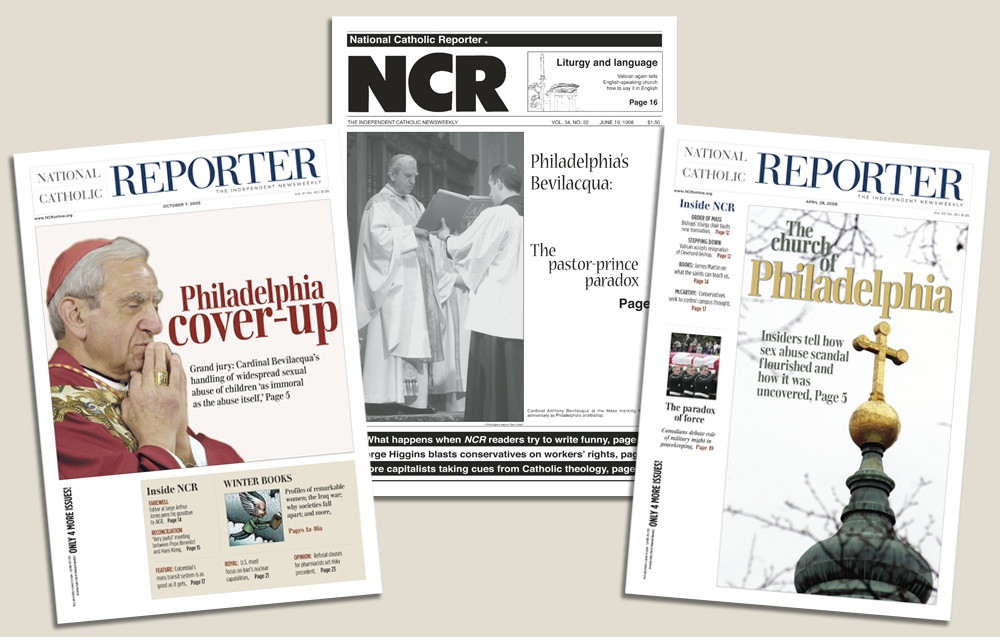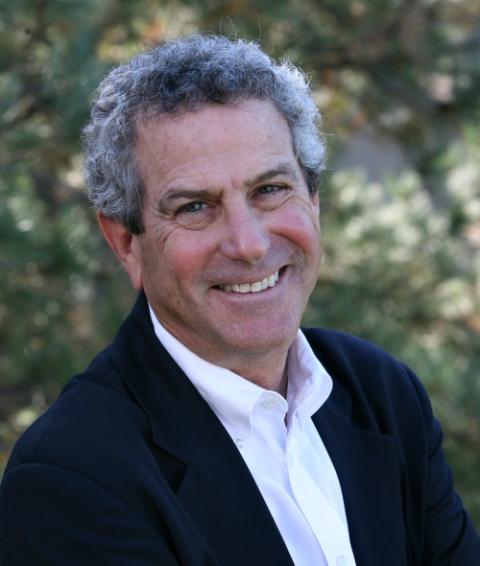
NCR's coverage of the Philadelphia Archdiocese was some of the reporting over the years that began to pull the veneer off clerical/hierarchical culture. (NCR graphic)
California has a reputation for being the state where political trends begin. I hope that kind of influence extends to the church, because that state's Catholics, and notably its bishops, have taken a very smart approach in countering a law permitting euthanasia.
In this time of gloomy church news (yes, there's some of that below, it's inescapable), the initiative in California could point to a new way of being church when engaging with worrisome cultural trends and statutes.
The California End of Life Option Act, which allows physician-assisted dying, took effect in June 2016 and has a sunset date of 2026, which means the law will cease unless new legislation is passed.
The intent of the Whole Person Care Initiative, a combined program of the state's bishops, the California Catholic Conference and the Alliance of Catholic Health Care, is to make the law unnecessary. "One of our goals is that at the end of 10 years that no one sees the need to renew a law like that because we've changed the conversation and people are aware of all the other resources that are available," said Greg Walgenbach, director of the office of life, justice and peace at the Orange Diocese.
"Through the Whole Person Care Initiative," as Heather Adams reported for NCR at the end of May, "all the Catholic bishops of California, the California Catholic Conference and the Alliance of Catholic Health Care have come together to create a statewide commitment to transform palliative and end-of-life care overall."
While other efforts to emphasize palliative care over physician-assisted suicide are underway in the archdioceses of Boston and Milwaukee, the difference in California, according to those involved, is the complete buy-in and commitment of all of the state's bishops.
The other big difference from the approach the bishops nationally have taken on other difficult issues is that the focus here does not involve engaging a political strategy to upend a law. The focus, instead, appears to be showing a different way. This is persuasion by doing, by witnessing, not preaching.

Dr. Ira Byock is assisting in developing the curriculum for the Whole Person Care Initiative in California.
The doing involves development of a 10-hour "train-the-trainer" session to be available in parishes. It will educate Catholics on the church's teachings (often misconstrued or misunderstood) on end-of-life care, as well as teaching people to have the difficult conversations required around a subject we'd all rather not talk about.
"It really is meant to change the culture both within the church and within our health care setting on how we care for persons who are seriously ill or dying," said Lori Dangberg, vice president of the Alliance of Catholic Health Care.
Full disclosure: I've heard a great deal over the years from my wife, Sally, a longtime hospice nurse, on the need for such changes in the culture. Long ago, she introduced me to the work of Dr. Ira Byock, a writer and important advocate for palliative care, a figure she has found inspirational in her work. Byock, founder and chief medical officer for the Institute for Human Caring of Providence St. Joseph Health, based in Gardena, California, is assisting in developing the curriculum for the Whole Person Care Initiative.
This is an important story about an important issue being advanced in a way that could serve as a model well beyond California.
The sex abuse crisis, horrible as it is, is but a symptom of deeper maladies in the clerical/hierarchical culture.
That sentence, or some form of it, has appeared countless times on our editorial pages and in commentary in this publication for decades. The assessment was made with assurance not as the result of some gnostic insight into a hidden world, but as the result of what editors, past and present, had themselves experienced in the Catholic world and as the result of deep reporting that began to pull the veneer off the clerical/hierarchical culture.
What we are witnessing today is the acceleration of what has been a slow-moving implosion of clericalism, especially of the hierarchical version, that has been underway for decades. The cases of former Cardinal Theodore McCarrick; of Cardinal Donald Wuerl; of Bishop Michael Bransfield; of the ongoing rantings of the hidden-away Archbishop Carlo Maria Viganò; the news of law enforcement invading the offices of Cardinal Daniel DiNardo, president of the U.S. Conference of Catholic Bishops; and the bishops gathered in Baltimore in an unusual spring meeting, having a second go at coming up with a system to hold themselves accountable — all of these are like lingering pulsations generated by detonations long ago.
They constitute affirmation after depressing affirmation that the hierarchical culture is disintegrating as a result of internal corruption. This has been going on for a long time. In June 1998, NCR published a 9,000-word profile/exposé of Cardinal Anthony Bevilacqua and his lavish spending, including hundreds of thousands in embellishments to the cardinal's mansion, at the same time the archdiocese was closing parishes in the poorest sections of the city.
Advertisement
Philadelphia for decades represented the high mark of clericalism, and its archbishops were truly princes. Bransfield grew up in Philadelphia and undoubtedly imbibed the atmosphere and expectations of the episcopal high life during his years of training at St. Charles Borromeo Seminary.
Bevilacqua, both a canon and civil lawyer (so he knew well all the legal loopholes), would later be exposed as an exemplar of episcopal arrogance in his handling of sex abuse cases. If you think the most recent Pennsylvania grand jury report — covering six dioceses in the state — was a tale of outrage, take the time to delve into the original Philadelphia grand jury report. There is no more exhaustive treatment of the findings than the 2005 story for NCR by Ralph Cipriano. Warning: It takes a strong stomach to make it through the findings.
And one of the best windows into the clerical/hierarchical culture was provided by Mike Newall in 2006, then a freelancer and recent graduate of Catholic University of America and now a columnist for The Philadelphia Inquirer. In a follow-up to the grand jury report in that city, he tracked down victims and clerics who knew the inside story for a compelling look at the cover-up.
Later, three stories by Jason Berry would show that money could buy protection in the Vatican for one of the most notorious and duplicitous of abusers, Marcial Maciel Degollado, founder of the Legionaries of Christ order and one of Pope John Paul II's favorites.
The point in all of this? The rot lies deep in the culture. The abuse and cover-up are ugly symptoms. It is important to note that simultaneously, and perhaps inevitably, trends are moving in a new direction. The mansions in Philadelphia and Boston, for instance, have been sold. Chicago Cardinal Blase Cupich decided against moving into that city's cardinal manse to live with fellow priests in a rectory. And, of course, the hierarchy today is all about steps to accountability.
At the same time, it must be recognized that the latest action taken in Baltimore — to add bishops to those accountable (though bishops watching bishops seems to be a less-than-ideal solution) — is but one more adjustment forced by outside pressure and bad publicity.
DiNardo may think, as he put it, "We were up against real challenges over the past year." The sad reality is that the past year was merely more of the same that had been going on for a lot of years. The church has been up against and overwhelmed by real challenges for years. It's just that the rubble heap that's accumulated from the disintegration of the hierarchical culture has grown to such proportions no one can any longer ignore it.
Bevilacqua has died, as have others who were most involved in the cover-up. Others have retired. Many of the bishops in place today were not directly involved, but they're inheritors of the culture. They are the only ones able to deal with the mess the culture has delivered them.
As much as bishops tout ecclesial lineage, they stand today as the only ones who can do the most difficult part. What's left is the interior work required to understand how the leaders of the church reached the point where the betrayal of its most vulnerable could occur over such a long period. For that, the bishops have to consult the catechism they wrote. It's stuff basic to our sacramental tradition. And it's the one thing that no one outside the culture can force them to do.
[Tom Roberts is executive editor of National Catholic Reporter. His email is troberts@ncronline.org.]








